Avocado:
What is it?, History, cultivation, nutritional value, uses, recipes, and more...
Avocado, also known as “aguacate” in Spanish, is the fruit of the avocado tree. It is a species native to Mesoamerica that has spread worldwide due to its versatility in various dishes, excellent taste, and numerous nutritional qualities.
Índice
What is an Avocado?
The avocado, also known as “aguacate,” is the fruit of the tropical avocado tree, scientifically known as Persea americana.
The avocado tree is quite robust and can reach heights of up to 30 meters. Its root system is relatively shallow, lacking visible root hairs, but it has many secondary branches under normal conditions. Its stem has moderately hard and rough wood, which is not very resistant to strong winds. The leaves of the avocado tree are alternate and vary in shape from lanceolate to oval, measuring approximately 10 to 40 cm. The avocado flowers are small, hermaphroditic, and have six oblong tepals, each about half a centimeter long. They are grouped in panicles that usually appear terminally or subterminally in the latest vegetative growth.
The fruit, the avocado, is a single-seeded berry, oval-shaped, with a smooth or rough surface, and green in color (depending on the variety). It typically measures 5-6 cm in length and weighs around 200 to 400 grams, although specimens weighing up to 2 kg can be found. The avocado flesh is oily, yellowish-green or cream in color, with an exquisite taste, and it contains a single round seed measuring between 2 and 4 cm, which is covered by a thin woody layer.
History of the Avocado
The avocado is believed to have originated in the highlands of southern Mexico and northern Guatemala.
The earliest evidence of avocado consumption dates back to 8,000 to 7,000 BC and was found in a cave in Coxcatlán, Puebla, Mexico. Additionally, the Mendocino Codex, created in the 1540s, contains hieroglyphics referring to the Ahuacatlán village, which means “place of abundant avocados.”
Avocados were cultivated in extensive regions of Peru during pre-Columbian times, as mentioned by Garcilaso de la Vega in his “Royal Commentaries of the Incas,” written in 1605. He mentioned that Tupac Inca Yupanqui marched to the province of Cari and conquered another province called Palta, from where they brought this delicious fruit called “Palta” to the warm valley near Cuzco.
The first technical description of the avocado was made by Francisco Hernández in his work “History of the Plants of New Spain” after his exploration of Mexican territory from 1571 to 1576.
The conquistadors brought avocados to Spain around the year 1600, as documented in records at the Valencia Botanical Garden, and from there, its distribution spread worldwide.

Common Names of Avocado
| Español | Aguacate, palta, cura, avocado o abacate |
| Italiano | Avocado |
| Griego | Avocado |
| Inglés | Avocado |
| Ruso | Avocado |
| Portugués | Abacate |
| Francés | Avocat |
| Gallego | Abacateiro, abacate. |
| Euskera | Ahuakateondoa |
| Catalán | Alvocat |
Scientific Name of Avocado
Persea americana
Taxonomy of Avocado
| Reino | Plantae |
| División | Magnoliophyta |
| Clase | Magnoliopsida |
| Orden | Laurales |
| Familia | Lauraceae |
| Tribu | Perseae |
| Género | Persea |
| Especie | Persea americana Mill., 1768 |
Synonyms of Avocado
Laurus persea L. non Willd. ex Nees
Persea americana var. americana
Persea americana var. floccosa (Mez) Scora
Persea americana var. angustifolia Miranda
Persea americana var. drymifolia(Cham. & Schltdl.) S.F.Blake
Persea americana var. nubigena (L.O.Williams) L.E.Kopp
Persea drymifolia Cham. & Schltdl.
Persea edulis Raf., nom. illeg.
Persea floccosa Mez
Persea gigantea L.O.Williams
Persea gratissima C.F.Gaertn.
Persea gratissima var. drimyfolia (Schltdl. & Cham.) Mez
Persea gratissima var. macrophylla Meisn.
Persea gratissima var. melanocarpa Phil.
Persea gratissima var. oblonga Meisn.
Persea gratissima var. praecox Nees
Persea gratissima var. vulgaris Meisn.
Persea leiogyna Blake
Persea nubigena L.O.Williams
Persea nubigena var. guatemalensis L.O.Williams
Persea paucitriplinervia Lundell
Persea (L.) Cockerell, nom. inval.
Persea steyermarkii C.K.Allen
Etymology of Avocado
Persea: The generic name used by Theophrastus, derived from the Greek, in honor of Perseus, the demigod of Greek mythology, to designate an oriental tree.
Americana: A geographic epithet referring to its location in America.
Aguacate: A word derived from Nahuatl “ahuacatl” [aːwakat͡ɬ], which dates back to Proto-Aztecan *PA:WA, also meaning ‘avocado.’ In Nahuatl, this word also means ‘testicle,’ probably due to the resemblance between the fruit and male gonads.
Palta: A term that comes from Quechua, possibly from the word “pallta,” which is used to refer to both a fruit and a load carried above. Additionally, it is the name of an Amerindian ethnic group, the Paltas, who inhabited the Ecuadorian province of Loja and northern Peru.
Hábitat de la Palta
- Habitat
Habitat of the Avocado
The avocado's native range includes the region between southern Mexico and Guatemala, and it has spread to all continents. The main producers are located in the Americas, while Oceania and Europe have lower production.
Avocados can be cultivated from sea level up to 2,500 meters above sea level. It is recommended to grow avocados at altitudes between 800 and 2,500 meters to avoid problems with diseases, mainly root diseases.
Regarding temperature, the avocado thrives in daytime temperatures around 15 to 20°C. Temperatures above 36°C can cause severe damage, especially during pollination and fruit setting. However, different avocado varieties have different temperature preferences based on their race.
Avocado plants require approximately 1,200 mm of well-distributed rainfall annually, and prolonged droughts can lead to leaf drop, reducing yield. Excessive precipitation during flowering and fruiting can also reduce production and cause fruit drop.
The most suitable soils for avocado cultivation are light-textured, deep, well-drained soils with a neutral or slightly acidic pH (5.5 to 7). However, avocados can also be grown in clay or clay loam soils as long as there is good drainage, as excessive moisture promotes root diseases like root asphyxia and fungal diseases like Phytophthora.
Geographical Distribution of Avocado

Arequipa, Lambayeque, La Libertad, Ancash, Lima, Ica, Ayacucho, Huánuco, Tacna, Junín, Apurímac
Seasonal Availability of Avocado
- March, April, May, June, July, August, September
Varieties of Avocado
There are around 400 avocado varieties, ranging from plum-sized fruits to those weighing up to 2 kg. Some well-known avocado varieties include:
-
Pinkerton
-
Negra de la cruz
-
Aguacates enanos
-
Reed
-
Bacon
-
Ryan
-
Fuerte
-
Wurt
-
Nabal
-
EL Edranol
-
Ettinger
-
Hass
Nutritional Value of Avocado
Avocado has a high content of unsaturated fat (linolenic acid and linoleic acid), as well as a high concentration of vitamin E, the most important antioxidant in human cell membranes, which is associated with a lower risk of cardiovascular and other degenerative diseases like cancer.
It is a suitable fruit for individuals with high cholesterol and diabetes. It is a source of potassium (containing 60% more potassium than a banana) and also provides magnesium.
Avocado also contains vitamin C, which acts against free radicals, as well as B vitamins, vitamin A, and folic acid.
Its high soluble fiber content helps regulate intestinal transit and reduce the absorption of cholesterol and sugar in the body, lowering their blood levels.
Health Benefits of Avocado
Avocado provides potassium and serves as a source of energy and healthy fats. It is also important for supporting the immune system.
Contraindications or Side Effects
Despite the undeniable benefits it offers to the body, avocado can be harmful if the recommended dosage is exceeded, which is one and a half avocados per day. Some possible contraindications include:
Due to its high fat content, it can contribute to weight gain, so moderate consumption is advised.
Although rare, excessive avocado consumption can lead to allergies, which may cause symptoms such as abdominal pain or itching in the mouth and throat.
Avocado contains anethole and estragole, two substances closely related to various liver diseases.
The carbohydrates present in avocados belong to the FODMAP group, which are difficult to digest, so an excess of these can cause constipation, gas, or abdominal pain.
| 10 Porciones por Kilogramo | |
| Tamaño de porción | 100g |
| Cantidad por porción Calorías |
130 |
| Cantidad por 100g | |
| Energía | 546 kJ |
| Grasa Total | 12.5 g |
| Sodio | ● |
| Carbohidratos totales | 5.6 g |
| Carbohidratos disponibles | ● |
| Fibra Dietaria | ● |
| Proteínas | 1.7 g |
| Calcio | 30 mg |
| Fósforo | 67 mg |
| Zinc | 0.64 mg |
| Hierro | 0.60 mg |
| Potasio | ● |
| Agua | 79.2 g |
| Cenizas | 1.0 g |
| Vitamina A | 7 μg |
| Tiamina (B1) | 0.03 mg |
| Riboflavina (B2) | 0.10 mg |
| Niacina (B3) | 1.82 mg |
| Vitamina C | 6.80 mg |
| Acido Fólico (B9) | ● |
| β-Caroteno | ● |
| Fuente: Tablas peruanas de composición de alimentos – Centro Nacional de Alimentación y Nutrición – Ministerio de Salud – Perú | |
Derived Products and Ways of Consuming Avocado
Uses of Avocado
The main use of avocado is in gastronomy. Avocado is a very versatile fruit that can be consumed raw or used in various preparations. It is also known for its nutritional benefits, especially its high content of unsaturated fats.
- Culinary
- Medicinal
- Industrial
Culinary Use of Avocado
Although avocado is commonly considered a vegetable, it is actually classified as a fruit and can be consumed both on its own and in various preparations. It can be spread on sandwiches, added to salads, used in sauces and dressings, served as a side dish, or used as a decorative element in cocktails, ceviches, rice dishes, soups, broths, and more. It can also be used to thicken certain desserts or even make ice cream, where avocado puree replaces milk or cream. Its high fat content makes it suitable for making "lectonesa" (or milk-based mayonnaise) by substituting oil with avocado.
In Mexico and many other Latin American countries, avocado is well-known as a fundamental ingredient in sauces that accompany various traditional dishes like tacos or tequeños. In Peru, it is commonly used in popular dishes such as stuffed avocados or "causa rellena."
To choose a ripe avocado, look for a firm fruit that is heavy for its size, with no blemishes or bruises on its skin, and that yields slightly when gently pressed with a finger. It is recommended to prevent oxidation by lightly sprinkling lemon juice on cut avocado to preserve its original color.
Medicinal Use of Avocado
The main benefits of consuming avocado are:
It is excellent for maintaining good eyesight and preventing conditions such as cataracts or macular degeneration.
It is recommended for strengthening the heart, as it provides significant levels of folic acid.
For pregnant women, including avocado in their diet periodically is advised because it helps the fetus grow and develop normally, reducing the risk of various malformations.
From an aesthetic point of view, consuming avocado promotes brighter, smoother, and more flexible skin.
It helps prevent cancer.
It is a good food for reducing cholesterol levels.
Industrial Use of Avocado
The main by-products obtained from avocado industrialization are:
Biopesticides
Organic Fertilizers
Avocado Oil
Creams
Shampoos
Bronzers
Crushed Seed
Cosmetics
Pharmaceuticals
Antioxidants
Food Additives
Vitamins
Thickeners
Residual Fat
Infusion Use
During 2020, despite the COVID-19 state of emergency, Peru became the world's second-largest avocado exporter, reaching 409,022 tons and reaching 34 international markets.



